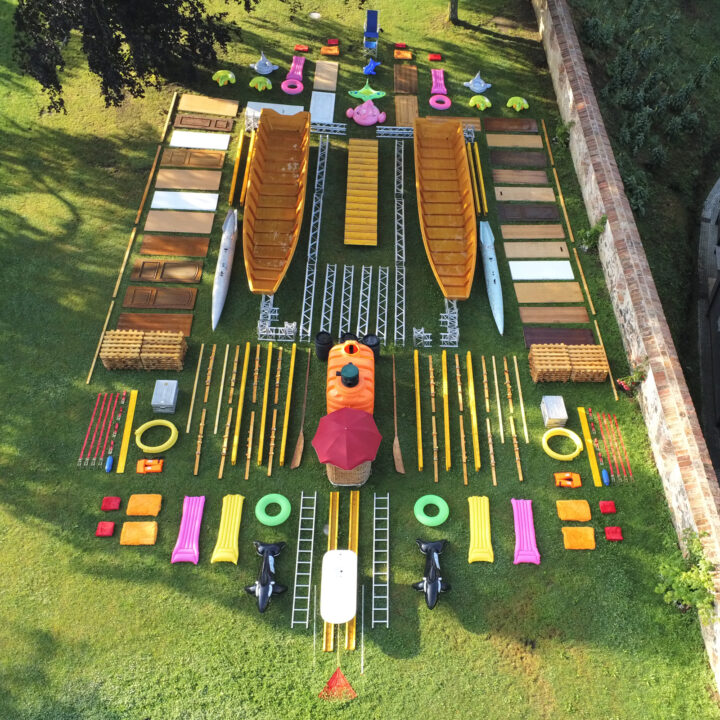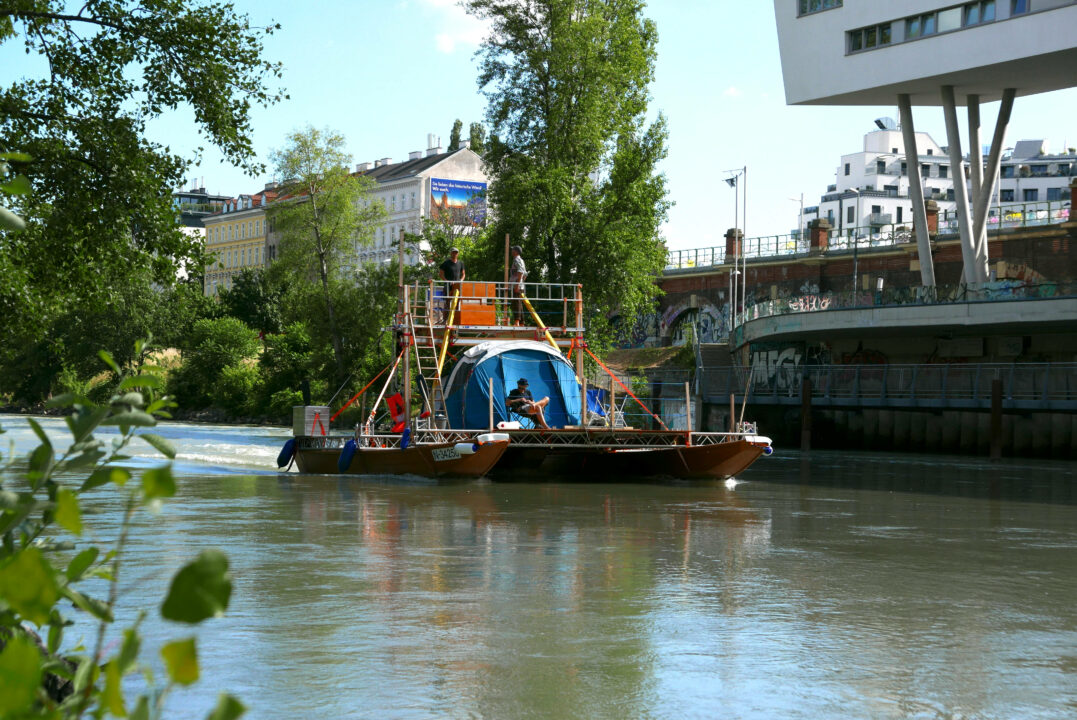The European Pavilion 2024: Liquid Becomings
14 Feb 2024
The laureate of the 500,000.00 euros commissioning grant awarded by the European Cultural Foundation for curating and hosting The European Pavilion 2024 was announced at a press conference held at Het Nieuwe Instituut in Rotterdam on February 14.
Selected by an independent jury, the consortium led by the independent artists’ collective espaço agora now, and comprising the organisations FLOW, MS-Fusion, Teatro Meia Volta and United Artist Labour, presents Liquid Becomings: a traveling pavilion that takes the form of four boats sailing on four European rivers for twenty-eight days, before coming together in Lisbon for a final artistic programme in November 2024.
Naomi Russell, founder of espaço agora now: “We are incredibly proud that the jury chose our initiative. The format is atypical for several reasons: not only will there not be a physical pavilion, but the way Liquid Becomings is created is different in the sense that it is an artist-developed and artist-led initiative. Through Liquid Becomings we will create many small agoras on four European rivers, where artists and communities come together to share lived experiences and co-create new narratives, addressing the complex polycrises of inequality and distrust, degradation of nature, climate change. By listening to the stories of ordinary Europeans outside the usual centers, among others, we want to contribute to redefining the future of Europe.”
About Liquid Becomings
Liquid Becomings is not a traditional Pavilion. It is not an exhibition. It is not even in a single location. Liquid Becomings is a journey, an adventure, a radical experiment.
Setting sail on September 1 for 28 days, four boats will travel simultaneously along four European rivers: the Danube, the Vistula, the Rhine, and the Tagus, crossing a total of thirteen countries. Their crews of artists and captain will each focus on different themes: Ruins and Monsters, Perimeters, Togetherness, and Bodies and Politics. Each boat will make space for the communities and people they meet along the way to come together and share conversations and creativity, to explore and imagine the stories that will be told by the Europe of tomorrow – stories inspired by these four great waterways.

The boats, each with a crew of 5 artists and a captain, are committed to imagining alternative modes of togetherness. The artist crews will research ideas of new imaginaries, alternative living and speculative futures. Each of the boats are simple vessels that offer a simple, sustainable and slow mode of travel. We expect to experience the landscape, the elements and people who live on the rivers from a unique, connected perspective. This is a journey that is participative and contributory.
In November the crews of all the boats will join forces in Lisbon. A three-day artistic programme celebrating polyphony, liminal spaces and itinerancy, will link the old port of Beato with Quinta Alegre, a socio-cultural complex located on the northern outskirts of Lisbon. The encounters and conversations, meals, rituals, stories from the journeys will be translated into a new mythology for Europe, told by artists and citizens.
From open call to Liquid Becomings: jury considerations
Following the Open Call for curatorial proposals to develop and host The European Pavilion 2024 we received 39 daring proposals. Most of these involved international collaborations and artistic productions, and twenty of them were led by consortia that together represented over thirty countries from all over the continent and beyond, stretching from Turkey to Denmark, from Ukraine to Portugal, and from the Netherlands to Greece. An independent jury chaired by Sepake Angiama selected one laureate from among the five finalists.
For the jury, Liquid Becomings envisions a daring artistic format. Importantly to them, it also presented a challenge to the orthodox model of national pavilions, originally founded in the colonial era, and what they represented.
The jury thought the ECF offer of a European Pavilion to be an opportunity to have the courage to walk away from the concept of the pavilion as purely a built space that audiences are obliged to come to, and to invent something new and decentralising that goes out to Europe’s communities.
The jury was taken by the symbolism the proposal represents: Liquid Becomings choreographs an artistic flow across Europe’s modern and increasingly impermeable borders, by launching small boats carrying a diverse group of artists down its ancient trading and people routes – the Vistula, Rhine, Danube, and Tagus rivers.

In the run up to the unveiling of Liquid Becomings as the winning proposal for The European Pavilion 2024 we asked Naomi Russel of espaço agora now and Lore Gablier, Programme Manager at ECF, to answer some questions.
We asked Naomi what Europe in reality is, and how our imaginations can shape it?
Naomi: “I will ask the question back! What is Europe in reality? The challenges the world faces leave no continent or nation untouched. This necessitates that Europe – we – need to question constructions and narrations of both history and imagination. In Liquid Becomings we want to reexamine the European sense of belonging, in the context of migration and global changes in social geographies. We want to look for new European mythologies by introducing transnational, multicultural exchange of knowledge and practices.”
In what ways is Liquid Becomings symbolic of the European project?
Naomi: “Liquid Becomings will investigate myths, narratives and discourses that build contemporary European identity. The floating pavilion explores bodies of water as its stages, which creates an unusual relationship between the sailing artists, as well as with audiences. Liquid Becomings proposes to treat the process as equal to an artwork and see sharing time, attention, energy and resources as a performative and political action. We believe that a future imaginary of Europe must allow for active engagement of Europe’s plural societies and polyphony of voices and experiences, drawing in especially those who sit outside established and institutional structures. By sailing waters, when we will be the strange people on the rivers – the other – we hope to reach them and, what’s more, hear what they think and feel and desire for the future.”
How can artistic imagination and creative ideas contribute to building fairer and more sustainable societies for all?
Naomi: “espaco agora now believes that we need the voices of independent artists at the centre of society because their imaginations and ability to see the future is fundamental to solving the great challenges of today. The environmental scientist Gus Speth who founded the World Resources Institute put it in a nutshell a couple of years ago when he said: “I used to think that the top environmental problems were biodiversity loss, ecosystem collapse and climate change. I thought that with 30 years of good science we could address those problems. But I was wrong. The top environmental problems are selfishness, greed and apathy. To deal with those we need a spiritual and cultural transformation. And we scientists don’t know how to do that.” This is where artistic imagination and artistic practices play a unique role, especially where citizens can be active participants and responders to the process of creation and as ideas are forming.”
Lore: “Maybe we should start by asking ourselves what makes our societies unsustainable and unjust. Isn’t there a certain status quo that we should start by deconstructing? And isn’t it precisely the arts that shake us up, that push us to imagine a different world reality, a different world order? That said, achieving a more sustainable and fairer society for all will require more than imagination. Two of the selection criteria for the laureate of The European Pavilion commissioning grant are sustainability and diversity: candidates are required to propose tangible measures, whether in terms of governance, representation, salaries, production, etc., to make their curatorial proposals respectful of people and the planet. So, with The European Pavilion, our ambition is also to set up an exemplary artistic event, where sustainability and equity are not only an artistic and intellectual concern, but are also what guides its concrete implementation.”
In what ways is The European Pavilion different from similar events elsewhere in the world?
Lore: “Perhaps the most distinctive feature of The European Pavilion is its explicit focus on Europe. There are many festivals and other artistic events with a European dimension (because of their partnerships or their itinerant nature, for example), but none of them puts Europe at the centre of their programming. What’s more, despite its name, The European Pavilion is not a built or fixed space, but one of experimentation and exploration. The idea is to question the very notion of the pavilion, whose genealogy is rooted in Europe’s colonial history and the construction of national imaginaries. With The European Pavilion, we invite cultural organisations and artists from all disciplines to reflect on Europe and imagine what it could or should become. It is their creative processes and artistic productions that give shape to The European Pavilion: for example, the 2024 European Pavilion will take the form of four boats sailing on four European rivers for twenty-eight days. But it could just as easily become a stage, a film, a virtual environment, a school, and undoubtedly take on a form as yet unexplored.”
Successfully putting together The European Pavilion is a massive, collaborative effort with different responsibilities. How, through the metaphor of the pavilion, can we make Europe a success?
Naomi: “I am going to paraphrase Tania Brugera here and her recent performative action in Hamburg. We need to talk. We must. And we need to suspend our prejudice and take time to listen when we engage in such dialogue. Pluralism is by its nature conflictual. There will always be a multiplicity of perspectives. Chantal Mouffe, from whom we took inspiration about the concept of horizontal agonism from when we started to imagine our curatorial proposal talks about the necessarily conflictual nature of pluralism and the impossibility of reconciling all points of view. She goes on to say, and I like this definition – when constituting a ‘we’ we must distinguish it from a ‘they.’”

'A future told by the river, a future told by all of us.'
espaço agora now expects a total of 46 independent artists from the performance fields to be involved in Liquid Becomings. They will open an invited call to artists to apply for a residency on the boats as they want to include as diverse a group of artists in the Pavilion as possible, including artists based outside Europe including in the Global South.
Naomi: “We wanted to create a proposal that reaches the perimeters and will be outside of the usual centres. Too many people in our society feel alienated and left behind. The simple act of reaching out and going to meet people where they are seemed urgent. Because of the European dimension we felt it necessary to reach as many territories as possible.
This meant we had to rethink the concept of being in one fixed place. Our concept started to form around how the only way to make space for a future imagining of Europe was by celebrating the liminal state, immersing into the not-knowing, and building an environment for new orders to emerge. Each river traces different routes and connects different regions.”
As well as inviting local experts to the boats on the various routes, Liquid Becomings will offer paid work to local people along the route producing their experiences. In the preparation for each route they will cooperate with at least five civil society partners per river.
And once the boats are sailing the public will be able to visit the boats free of charge. Please make sure you follow the different stages and trajectories of Liquid Becomings via The European Pavilion.
